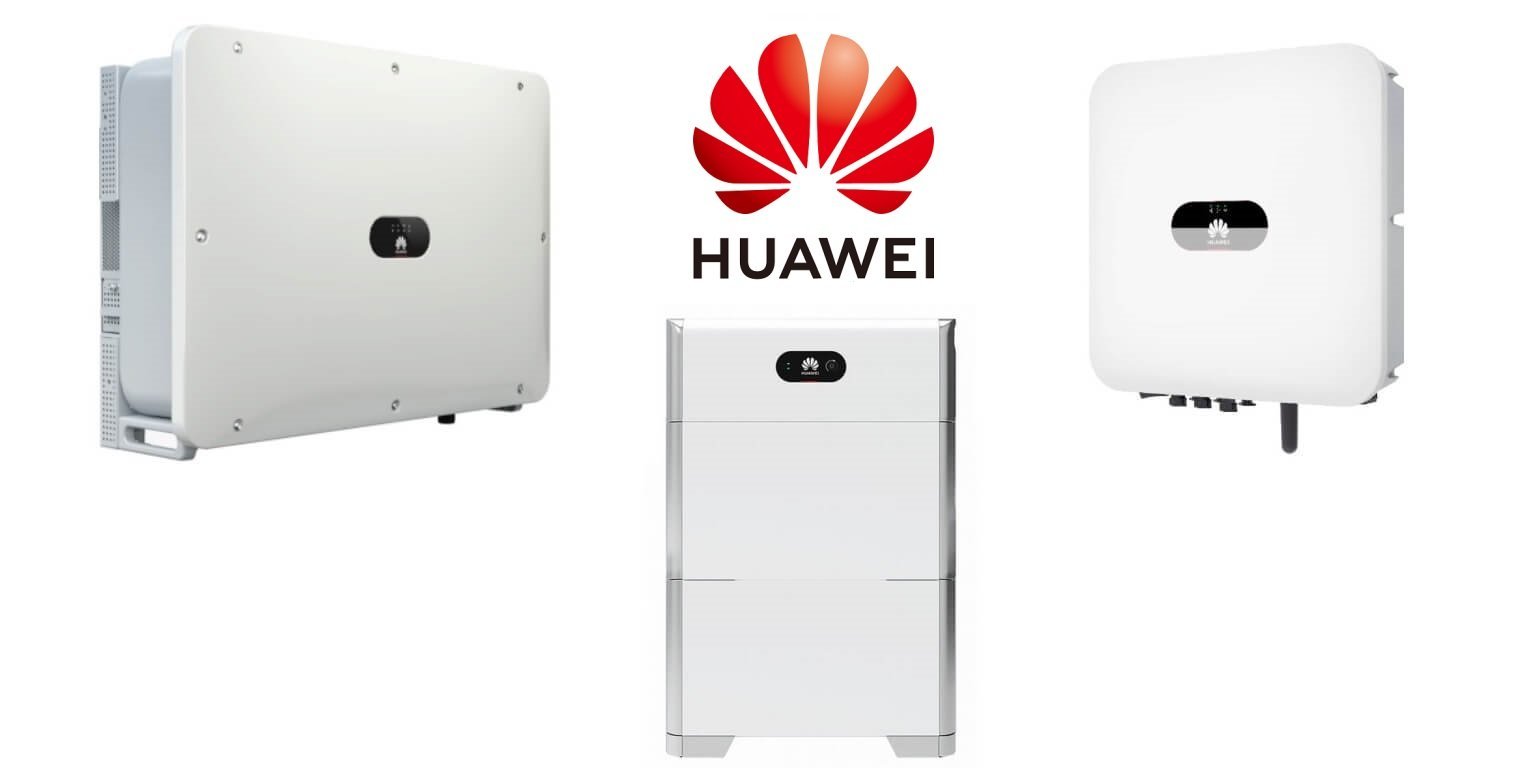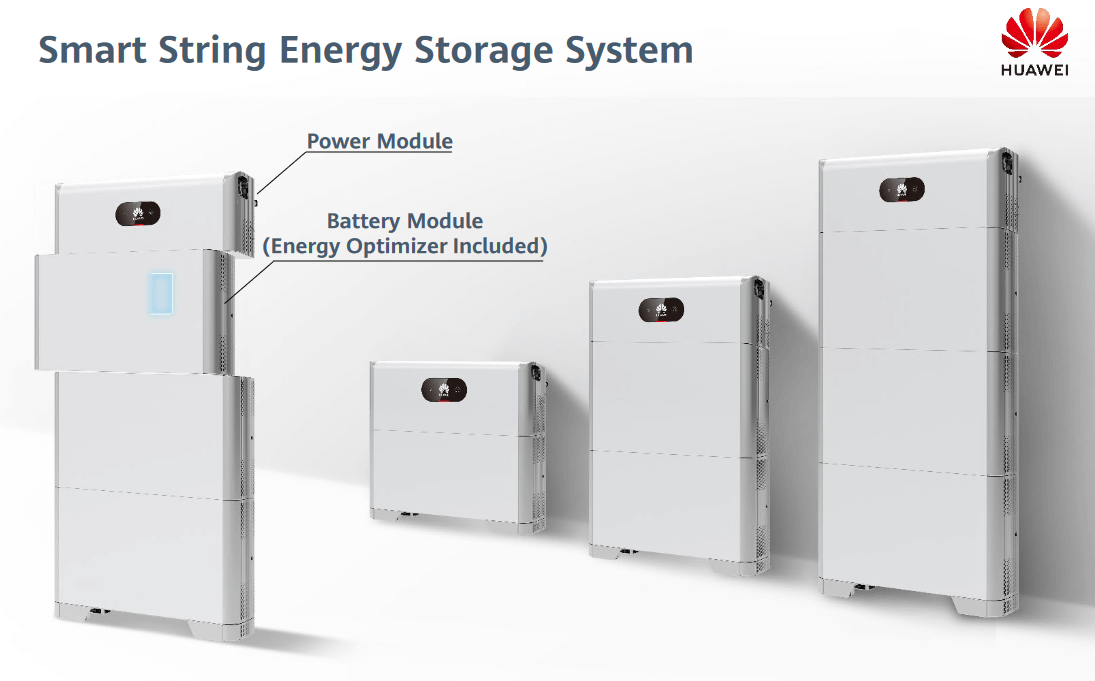Huawei Inverter and Battery Review
home > solar inverters > best inverters review > Huawei inverter and battery review
Huawei has a reputation as a leader in communication and mobile technology, but it’s not well-known that the company is a global powerhouse for solar technology. Building on decades of experience in large-scale commercial and utility solar, Huawei jumped into the residential solar market in 2018 with an efficient, lightweight hybrid solar inverter offering an impressive range of features at a competitive price. Then, only two years later, Huawei released the second generation residential hybrid inverter, a new compact optimiser, a range of 3-phase hybrid, and large commercial inverters with advanced capabilities.
Company background
Huawei pronounced “Hua-Way’ is a Chinese communications and technology company mainly known for its mobile phones. The company ranks 44th in the Fortune Global 500, and operates in more than 170 countries and regions, with over 197,000 employees. Huawei has staggering research and development capability, with 53.4% of the workforce dedicated to R&D and ranks 3rd in the EU Industrial R&D Investment Scoreboard.
Huawei has a strong foothold in the global PV market. According to reports released by IHS Markit and Wood Mackenzie, Huawei has been ranked No. 1 in global inverter shipment for six consecutive years since 2015, accounting for 23% of the worldwide market in 2020. Interestingly, they only build string solar inverters, not central inverters, and believe string technology is superior, becoming the industry trend due to improved monitoring and less costly maintenance.
Residential Solar Inverters
The Huawei FusionSolar hybrid inverter
The second-generation residential solar inverter was released in April 2020, only two years after the first version. The SUN2000-L1 series ranges from 2kW to 6kW and features ‘dual MPPTs’ with a wide operating voltage range of 120V to 600V. Like the first-generation inverter, the new FusionSolar SUN2000-L1 series is a hybrid or battery-ready inverter compatible with the LUNA2000 Huawei battery system described in detail below. The SUN2000L inverters allow very short strings of 4 panels and the flexibility to function with or without optimisers (more about optimisers below). Oversizing solar is allowed above the typical limit of 150% of the inverter rating so long as the maximum string voltage (Voc) and current do not exceed the specified input limits.
SUN2000 Inverter Basic specifications - Single-phase and three-phase - Image credit Huawei
On top the respectable specs is the compact, lightweight, design featuring natural convention cooling via the large rear heat sink, meaning no cooling fans. There is no display screen, having only 3 LED indicators and setup and configuration is via a new, easier to use, mobile App. The new inverters also feature an integrated DC isolator which is certified to Australian standards, but of course the big ticket winners are the optimisation and plug and play battery capability as explained in more detail below
See the full Huawei Inverter SUN2000-L1 specification sheet
Smart Panel Optimisers
A stand-out feature of the SUN2000L1 inverter range is the ability to function as a standard stand-alone string inverter, with partial optimisers or full panel optimisation. No other inverter manufacturer has managed to deliver this, and solar installers like more flexibility when installing systems, giving Huawei a big advantage. Optimisers can be used without any additional components. The first-generation Huawei inverters required the smart PV safety box add-on unit, but fortunately, this odd-looking device is no longer required.
Optimisers, technically known as MLPE (module-level power optimisation), have been available for many years from manufacturers like SolarEdge and Tigo Energy. However, the Huawei smart PV optimiser’s ability to be partially deployed on only the panels that suffer shading is something that previously only Tigo optimisers offered. Much like microinverters, optimisers offer several benefits over standard string inverters. Below are some common solar performance problems optimisers help overcome, in addition to fault detection and panel-level monitoring.
Shading – Trees, buildings, poles, wires, antennas, or rooftop structures
Panel mismatch – manufacturing tolerances
Panel damage – micro cracking, hot spots or water ingress
Temperature difference – thermal mismatch at different times of the day
Soiling – Dust, snow, bird droppings or birds
PID – Potential voltage and current leakage issues
Additional benefits of optimisers
Multiple panel orientations on one string
Different panels on one string – ideal for upgrading old systems
Maximise roof space – shading in winter is less of an issue
Can install parallel strings of unequal lengths
Monitoring at the individual panel, string and inverter level.
Remote troubleshooting via the monitoring portal
Added safety - Zero string voltage when the inverter is switched off
SUN2000 450W-P & 600W-P optimisers
Huawei released two more powerful optimisers in 2022 catering for the new high-power 450W+ solar panels on the market. The next-generation SUN2000-450W-P2 and SUN2000-600W-P optimisers feature a power rating of 450W and 600W respectively, a maximum input current of 14.5A, up from 13A, and a wide voltage range from 10V to 80V. This means short strings of 4 panels can be used with full optimisation, which provides great flexibility in designing systems with shading issues. Huawei uses the ‘Powerline’ style communication system, which transmits data via the DC cables connected to the panels.
Advanced arc fault detection
With the increased focus on safety, especially in the US solar market with the strict regulations, the new Huawei optimisers offer advanced arc fault detection (ACFI) and rapid shutdown in the event of damage or a fault in the solar array. Huawei has spent a lot of time developing an AI-powered AFCI detection system which has so far proven to be one of the most reliable and effective systems currently available.
Huawei LUNA2000 battery review
Huawei recently launched a new, in-house developed energy storage system (ESS) to suit the Huawei Sun2000 hybrid inverters. The stackable battery system comprises high-voltage 5kWh modules, each operating at the optimum voltage and functioning independently. This is unique compared to other high-voltage battery systems that work in series. Huawei claims this will help increase the lifespan and durability as each module is self-managed and will not affect the performance of the other modules in the stack if there are variations such as temperature or age, such as if an additional module is added later. This means you can add new modules at any time, even after ten years, and each module will still perform at full capacity.
See how the LUNA2000 battery compares in our home battery cost comparison.
The Huawei Luna2000 modular battery system with 3 different size options - 5kWh, 10kWh and 15kWh. Image credit Huawei
In the field of energy storage, Huawei has accumulated more than ten years of R&D experience, so it is not surprising that the LUNA battery system is packed with many advanced features, including module-level optimisation. Each 5kWh LUNA2000 battery module contains an Energy Optimiser, which optimises the charge and discharge of each module independently. Since the modules are connected in parallel, Huawei claims this unique design can achieve up to 10% more usable energy and 100% depth of discharge (DOD).
Huawei LUNA2000 Battery key features
High Voltage Lithium (LFP) modules with 100% DOD
5kWh capacity per module scalable up to 30kWh
Power output per module, 2.5kW continuous, 3.5kW peak
AI-powered internal cell short circuit diagnosis to avoid fire hazards
Cell-level temperature control to detect overheating
Optimizer-enabled 0V rapid shutdown for safer installation and maintenance
Internal heating system for better performance in extremely cold climates
10-year warranty
The optimisation system allows new and old battery modules to each operate at their optimum capacity.
Modular battery system
The LUNA2000 batteries are made using lithium iron phosphate cells and can be stacked up to three high for a maximum of 15kWh of storage capacity per stack. However, the system can be expanded with a second stack offering up to 30kWh of total capacity with two stacks in parallel. Lithium Iron Phosphate (LFP) is widely known as one of the safest and most stable battery chemistries available for energy storage applications due to its wide operating temperature range and reduced risk of thermal runaway (overheating).
Compact, slimline design
Huawei LUNA2000 battery system installed
The Luna2000 system is one of the most compact batteries available, with a very small footprint thanks to the slimline design, which is quite appealing compared to some of the other more box-like batteries. The top section of the battery system is the power module, technically known as a BMU or battery monitoring unit, which is similar to other stackable battery systems controlled via a top-mounted BMU to provide the interconnection and communication to the inverter. The Huawei power module has inverter connections for flexible connection options on either side, while the main isolation switch and an inbuilt fuse are located on the right-hand side. The front LED display features a round dial of ten LED lights to indicate the battery state of charge; this is a neat and unique way to indicate the state of charge.
High-voltage battery modules
As explained earlier, unlike most other modular high-voltage battery systems connected in series to increase the voltage, the Huawei battery modules are connected in parallel, and each operates at 350V to 430V. This offers a number of advantages, one being that the battery voltage of each module is very close to the inverter's optimum operating voltage, and the current is very low (12A at full power), resulting in low cable and conversion losses, making it more efficient.
Battery power output
The minimum battery size is 5kWh with one module, which limits the output power to 2.5kW. A second battery module increases the power output to 5KW, with a peak output of 7kW for 10 seconds. No more extra power is available by adding more battery modules on a single-phase system. However, the 5kW continuous output is more than enough for most households.
Battery management features for extreme climates
Huawei battery connections and features
Unlike most Lithium batteries on the market, which can suffer from severely reduced charge rates and even shutdown at temperatures below freezing, the LUNA2000 batteries contain a thermal management system that enables the battery to charge at very low temperatures. It achieves this through a small 300W heating element, which preheats the cells and improves low-temperature charging performance. This uses a small amount of energy but only activates the preheating function for short durations before charging. Interestingly, the battery modules also contain a small internal fan to help heat distribution in both hot and cold conditions. A large heat sink on the right-hand side of each battery module also enables greater heat transfer in high temperatures, which improves performance and increases battery life.
Download the full Huawei LUNA2000 battery specifications datasheet.
Optional Battery Back-up box
Huawei battery backup box
The rather bulky optional backup box features a 5kW backup power rating, which is more than enough for most essential loads that need to be backed up during a blackout. Generally, backup loads consist of lighting, basic power and simple kitchen appliances like fridges and microwaves. The box is quite large and not particularly attractive compared to the sleek-looking inverter and battery. It’s about the same size as the inverter and is packed with grid isolation contactors and relays to enable off-grid operation.
Energy meter required for battery storage
To use the battery function, like all hybrid inverters and energy storage systems, an additional energy meter is required to monitor energy flow to and from the grid and household circuits. This is available with CT clamp meters for both single and three-phase systems. The energy meter is installed inside the main electrical switchboard and a communication cable to feedback to the inverter to enable the inverter to know when to charge and discharge the battery depending on the solar generation and energy consumption in the home. See energy meter datasheet.
LUNA2000 battery cost
The Huawei battery is price competitive and comes in as one of the lower-cost battery systems when measured on a cost per kWh basis over 10 years. Regarding upfront cost, it’s also one of the lower options in our detailed solar battery cost comparison article, coming in at a little under $800 per kWh. With a Huawei SUN2000L1 solar inverter already installed, a 10kWh LUNA2000 battery system with two 5kWh batteries and a power module would set you back around $7800 Australian dollars, or US $5500 dollars, plus installation.
Battery warranty
Like most lithium battery storage systems available today, the Huawei Luna battery comes with a 10-year manufacturers warranty period which guarantees the battery will still provide at least 60% of its original capacity after a 10 year period. All batteries lose capacity over time and typically LFP cells are warranted to lose between 20% and 40% of their capacity based on a full charge and discharge cycle per day. Huawei’s warranty is at the lower end of the spectrum and is in line with other large manufacturers such as BYD and Pylontech.
Huawei battery warranty conditions - Note EOL refers to battery end of life
Reliability and Testing
Extreme temperature testing - Freezing -40 degC
Quality and reliability is the most important criteria in the world of solar, especially with several inverter companies either having recalls or multiple failures. We are yet to test the Huawei inverter in the harsh Australian summer/s but from the outset it seems Huawei have done some serious engineering to ensure this inverter will go the distance.
The overall build quality looks good with well built weather rated connectors but more importantly Huawei have done some extremely rigorous testing of their own at the Huawei global compliance and testing centre, carrying out some of the most extreme tests I have ever heard of including hitting the inverter with lightening! Yes that’s correct, they attached the inverter to a steel pole and shot a rocket with a cable into a thunderstorm to induce a lightening strike… Impressive and in some ways just insane! Apparently it was still functional afterwards so they blew it up with an explosive test as well. Seriously, but it wasn’t clear if it was still functional.
The lightening test being conducted
The Huawei EMC lab and testing facility is recognised by several leading international testing verification organisations including TUV, UL and FCC. They perform many extreme durability tests including thermal cycling, extreme humidity, salt-mist corrosion and even submerge the inverters underwater.
Service and Warranty
Much like in North America and Europe, Huawei are now well established in Australia with around 700 employees based in various service, sales and distribution centres in most capital cities. Huawei are keen to engage with the solar community and have already setup a training centre in Sydney along with a research and development centre in Melbourne.
Huawei inverter and optimiser warranty details
The new SUN2000 inverter series comes with a standard 10-year warranty, which is backed by a claims response time which Huawei are reporting will be less than 3 working days. See the Huawei online service portal here.
Huawei Commercial String Inverters
Considering Huawei built their reputation on larger scale 3-phase string inverters, it is no surprise that they offer a wide range of efficient, intelligent commercial and utility-scale string inverters from 8kW up to an impressive 330kW. With 3 MPPT trackers on the smaller 3-phase inverters, up to 6 MPPT’s on the 50 to 90KW units, 9 trackers on the 185kW model, and 10 trackers on the 100kW, they offer a very high level of design flexibility.
SUN2000-8/10/12/15/17/20KTL - 3 x MPPT
SUN2000-29.9/36KTL - 4 x MPPT
SUN2000-50/60KTL-M0 - 6 x MPPT
SUN2000-100KTL-M1 - 10 x MPPT
SUN2000-185KTL-H1 - 9 x MPPT
SUN2000-330KTL-H1 - 6 x MPPT
Inbuilt I-V Curve testing
Huawei have also developed some extremely sophisticated monitoring and tracking capabilities into the larger commercial inverters with powerline communication and smart I-V curve diagnosis. This is something that would normally require expensive equipment and testing so having this I-V power curve analysis built in is a huge plus.
PID Recovery
Another advanced feature is the integrated or optional PID (potential induced degradation) recovery system which is claimed to reduce the PID effect by up to 75%. This is an impressive feature and something large scale installers will be more than happy to see with many having suffered PID issues in the past causing all sorts of problems.
System Monitoring - FusionSolar
The new FusionSolar cloud-based monitoring portal is much better than the previous NetEco portal and offers an easy to read interface and many advanced monitoring and data logging features. The new FusionHome mobile app is also more intuitive and used for both inverter setup and direct connection and monitoring via local WiFi.
The new look Huawei FusionSolar monitoring app has a very modern and clean user interface.
Summary
The Huawei SUN2000L1 inverters are an impressive piece of engineering and a great, reliable option for those wanting a flexible 'battery ready' solar system. Regarding battery storage, the Huawei LUNA2000 battery system and add-on backup box seem to tick all the boxes and may become a strong competitor in the rapidly growing storage market.
While the residential SUN2000L inverters had good feedback and performed well, even in harsh Australian conditions, they have not become hugely popular in the highly competitive Australian market. However, they have been quite successful in Europe and the UK.
On the commercial side, the Huawei range of inverters offers some amazing functionality not provided by many other inverter manufacturers. With an impressive list of new larger models, local support, new software and smart ‘load’ control capability, Huawei looks to give some well-established inverter manufacturers like Fronius, SMA and SolarEdge a run for their money in the rapidly growing commercial solar space.


















